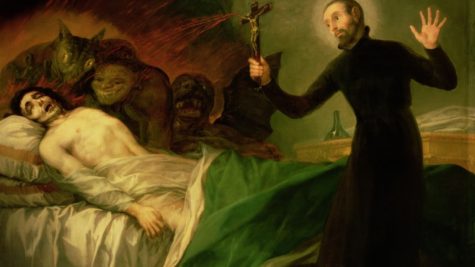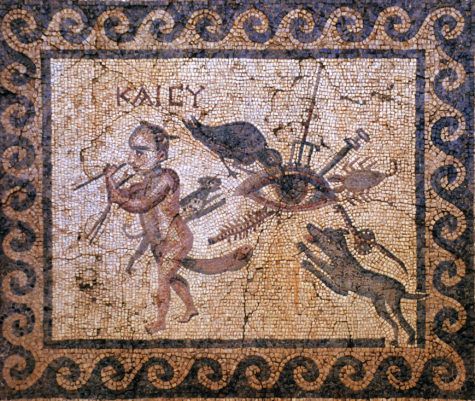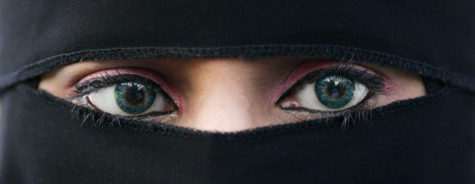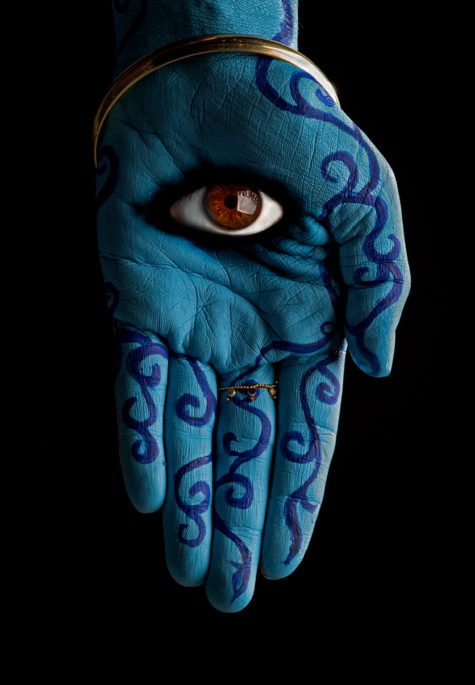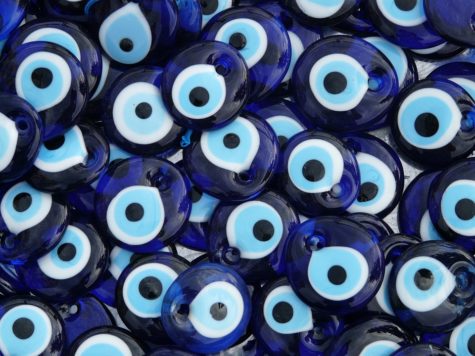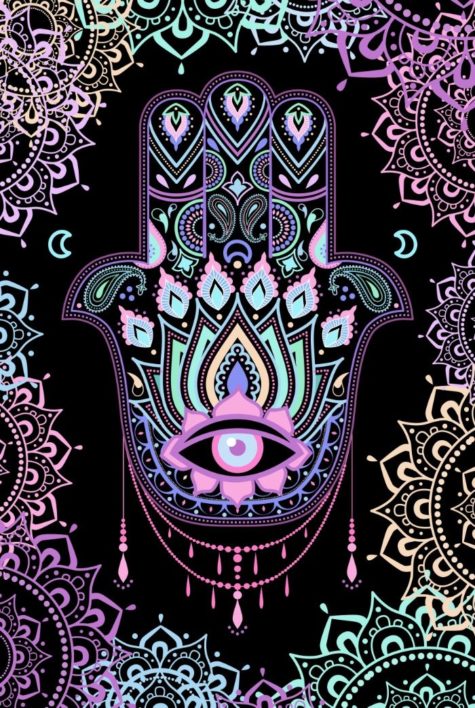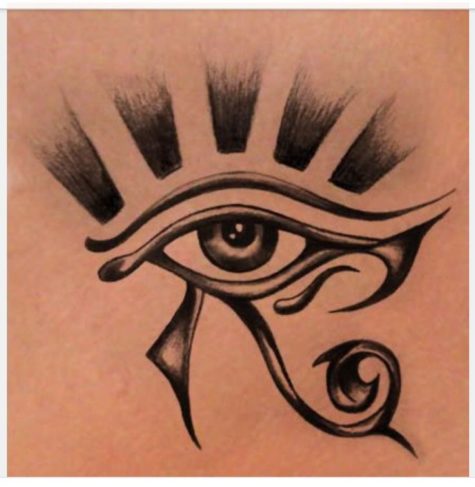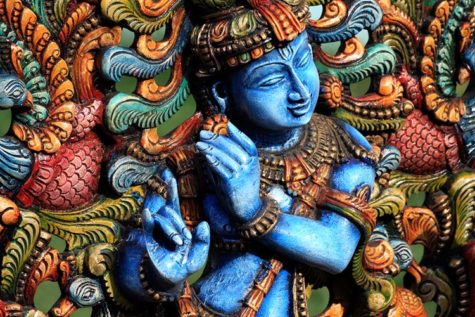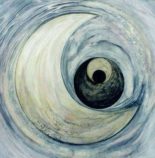Blue
The Evil Eye
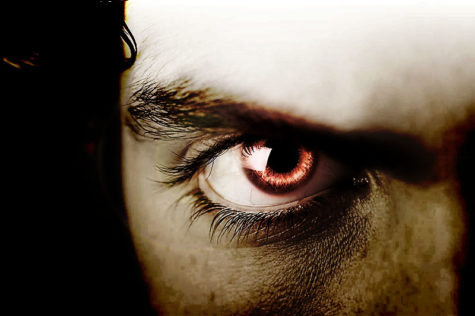
The evil eye is a specific type of magical curse. It is believed to cause harm, illness and even death.The evil eye is a specific type of magical curse. It is believed to cause harm, illness and even death.
Everyone gets a dirty look now and then, and we usually think little of it (especially if we deserved it). For most of us it is soon shrugged off, but in many places belief in “the evil eye” is taken very seriously, and requires immediate action to avoid harm.
The evil eye is a human look believed to cause harm to someone or something. The supernatural harm may come in the form of a minor misfortune, or more serious disease, injury — even death. Folklorist Alan Dundes, in his edited volume “The Evil Eye: A Casebook” notes that “the victim’s good fortune, good health, or good looks — or unguarded comments about them — invite or provoke an attack by someone with the evil eye …
Symptoms of illness caused by the evil eye include loss of appetite, excessive yawning, hiccups, vomiting and fever. If the object attacked is a cow, its milk may dry up; if a plant or fruit tree, it may suddenly wither and die.”
The evil eye is also said to cause a number of other maladies including insomnia, fatigue, depression and diarrhea. In many places, disease is considered a magical as well as a medical issue, and the reason a given person succumbs to a malady may be attributed to a curse instead of random chance or exposure to a virus. It can even affect objects and buildings: The evil eye cast upon a vehicle may break down irreparably, while a house so cursed may soon develop a leaky roof or an insect infestation. Just about anything that goes wrong may be blamed on the power of the evil eye.
The evil eye is essentially a specific type of magical curse. Let’s say that a person experiences bad luck, ill health, accident, or some unexplained calamity — perhaps a drought or an infectious disease. Before science could explain weather patterns and germ theory, any bad event for which there was not an obvious cause might be blamed on a curse. Curses, including the evil eye, are an answer to the age-old question of why bad things happen to good people.
Evil eye in history
The evil eye is well known throughout history. It is mentioned in ancient Greek and Roman texts, as well as in many famous literary works, including the Bible (such as Proverbs 23:6: “Eat thou not the bread of him that hath an evil eye, neither desire thou his dainty meats”) the Koran and Shakespeare’s plays. Though belief in the evil eye is widespread, it is not universal. A 1976 cross-cultural survey by folklorist John Roberts found that 36 percent of cultures believed in the evil eye.
The earliest known evidence for belief in the evil eye goes back to ancient Greece and Rome. It was believed that the evil eye was the largest threat to anyone who had been praised too much, or received admiration beyond what they truly deserved. The praised person would become so swollen with pride that he or she would bring about his or her own doom via the evil eye, which was believed to be able to cause physical and mental illness. In fact, any disease which did not have an immediate, obvious cause was thought to be caused by the evil eye. It was thought that the gods and goddesses were punishing those who had become too proud of their achievements, and destroyed them with the power of the evil eye to restore them to the level of mere mortals.
The symbol and superstition of the evil eye is one of the strongest symbolic images in the world. Yet, despite the differences in the cultures which hold the evil eye myth, it retains largely the same meaning no matter where the story is told. The evil eye is thought of as a look given to inflict harm, suffering, or some form of bad luck on those that it is cast upon. It is a look which clearly states that one intends for something bad to happen to the object of one’s focus, either out of jealousy or pure malice. The superstition of the evil eye holds that the malicious look is powerful enough to bring about actual disaster for the unfortunate person that is the receiver of the glare.
Eyes are said to have special powers; they are said to be the gateway to a person’s soul.
The evil eye is a powerful superstition in India. Hinduism preaches that the eye is the most powerful point at which the body can give off energy. Thus, a strong fear of an “evil” look from the eye makes sense; the evil eye holds enormous powers. The Hindus fear that even an “admirable” eye can bring about ill luck, resulting in the supply of milk from cows drying up (again, this idea dates back to the fear of undue praise, first warned against in Greece). In fact, the Hindus will offer the “admiring” glancer a bowl of milk to counteract the threat of the evil eye.
The Hindus also believe that jealousy is at the root of the power of the evil eye, whether in the form of a malicious or admirable look. Interestingly, the Hindus teach that the times of change in life–as in during puberty, marriage, or childbirth–one is most vulnerable to the threat of the evil eye.
Hindus believe that even animals such as the snake are capable of giving one the evil eye. They believe that, even though men are capable of casting the evil eye, women are the most common sources of the glance. For this reason, in South India women will paint their eyelids black to protect themselves from the evil eye, and to prevent themselves from eyeing another with the look.
In South America, Brazil holds a superstition equivalent to the evil eye known as the “fat eye.” Compliments which are sincere are not feared to cause the evil eye to attack as in other countries, but insincere compliments are thought to put one at stake.
In Europe, the myth of the evil eye also originated with the idea that envious or malicious looks had the power to bring about bad luck. The largest source of the evil eye was believed to be witches. Yet those with eye colors which were rare were also seen as powerful possessors of the evil eye look. For instance, Germans feared those with red eyes. In Ireland, those with squinty eyes were feared to be evil eye sorcerers. In Italy, the unibrow was another sign that one would cast an evil eye.
Shifting eyes are said to subtly betray liars, while a steady gaze may be endearing or menacing depending on the circumstances. Eye contact can create an intensely personal connection, whether between lovers or superiors and subordinates. Glaring or intense staring can convey power and authority over another. And of course, actors use their eyes to convey a wide range of emotions, including love, hate, disgust, boredom, scorn, surprise and envy. In fact it is this last emotion — jealousy — that underlies the evil eye’s cultural association with magic.
Belief in the power of the eyes is so powerful that any eye affliction has come to suggest evil and bad luck. People who are cross-eyed, have uncontrollable eye twitches or spasms (a condition called blepharospasm), or who merely have a prominent squint have been shunned and feared as provoking bad luck, especially among those who work in dangerous occupations such as fishing and mining. Similarly, those with unusually close-set eyes or eyes of different colors were often suspected of having the evil eye.
Babies and children are said to be especially susceptible to harm from the evil eye, and in many countries, including Greece, Romania, and India, praising a child publicly is sometimes considered taboo, for the compliment will draw the attention of the evil eye. In order to ward off the evil eye, parents of a thoughtlessly praised child may ask the person who gave the compliment to immediately spit in the child’s face. Because the momentarily exalted youngster has been brought down a peg, any harm by the evil eye is unnecessary; this spittle salve is harmless yet insulting enough to negate the compliment.
The fear of the evil eye did not carry over to America, except in the form of a metaphor. While the superstition is not intense enough to take precaution, the evil eye is seen as impolite, and a warning that the source of the evil eye has bad intentions.
Who has the evil eye? Maybe you do. Many believe that bad intention is not necessary, and that some people can cast an evil eye without even knowing it. If one person is believed to have the evil eye, other members of his or her family are often treated with suspicion — and any children are assumed to have the curse as well.
Methods of Protection against the Evil Eye
The best way to deal with the evil eye is to avoid it in the first place. The method varies by culture, geographic region, and personal preference. In Puerto Rico, for example, newborns are often given a good luck charm called an azabache to protect them from the evil eye.
In addition to the use of evil eye amulets, the Greeks would carry incense or the cross as protection against the evil eye. New mothers would keep objects as protection under their pillows or on their heads, and these included red, black, or white strings, a nail, gunpowder, bread, salt, garlic, a ring, indigo blue, or a pair of silver buckles. Each of these objects held a meaning which made it a good defense against the evil eye. For instance, gunpowder symbolized an ability to fight back against the evil eye. The nail symbolized strength. The indigo held its power in its blue coloring. Salt was a symbol of preservation and strength.
Amulets can be worn to deter the evil eye, often using the color blue (symbolizing heaven or godliness) and an eye symbol. Charms, potions and spells can also be prepared; garlic can be used to deter the evil eye, and some believe that just saying the word “garlic” offers protection.
The most popular method of escaping the evil eye’s effects in many cultures is by the use of evil eye talismans, evil eye symbols, and evil eye jewelry. These are meant to “reflect” the power of the evil look. The evil eye amulet originated in Greece, where it was known as an “apotropaic” amulet, meaning that it reflected harm.
The most basic design of the evil eye, prevalent in the Middle East, is a talisman designed with concentric blue and white circles made to symbolize the evil eye, known as the nazar. It is often used on houses, vehicles, or jewelry.
One of the most powerful examples of the evil eye amulet in the Middle East and Africa is the Hamsa, also known as the “Hand of Fatima.” The hamsa is a hand-shaped symbol with the evil eye on the palm. The hamsa can be used in wallpaper or jewelry to ward off the evil eye. The hamsa is also found in Jewish culture, where it is known as the “Hand of God” or the “Hand of Miriam.” The popularity of Kabbalah has revived the hamsa and influenced its presence in jewelry and design.
In ancient Rome, the most common amulets were used to avert the influence of the evil eye appears to have been the phallus, called by the Romans fascinum, which was hung round the necks of children. Pliny also says that Satyrica signa, by which he means the phallus, were placed in gardens and on hearths as a protection against the fascinations of the envious; and we learn from Pollux that smiths were accustomed to place the same figures before their forges with the same design.
Sometimes other objects were employed for this purpose. Peisistratus is said to have hung the figure of a kind of grasshopper before the Acropolis as a preservative against fascination Another common mode of averting fascination was by spitting into the folds of one’s own dress.
According to Pliny, Fascinus was the name of a god, who was worshiped among the Roman sacra by the Vestal virgins, and was placed under the chariot of those who triumphed as a protection against fascination; by which he means in all probability that the phallus was placed under the chariot.
Evil Eye Remedies
If these preventative steps failed, however, the Greeks had many more remedies against the evil eye. In some villages, the fur of a bear would be burned to cure the curse. In others, a gypsy would massage the forehead to get rid of the ill effects of the evil eye.
In many countries, including Greece, Armenia, and Assyria, it is thought that a pinch on the rear will remedy the curse of the evil eye. In Europe, some Christians have the tradition of creating the sign of the cross with their hands, while at the same time pointing the index and pinky finger toward the source of the evil eye. In Bangladesh, a black dot is drawn on the forehead of children to ward off the evil eye curse. Pretty young women have a secret dot drawn in kohl behind their ears to protect against the evil eye.
Often those who believe they have been harmed by the evil eye will seek out shamans, witch doctors, psychics or other spiritual healers to remove the curse.
In Latin America the evil eye is known as “mal de ojo,” and belief in it is especially widespread in rural areas. There are several ways to cure mal de ojo; one traditional method from Mexico involves the use of a raw egg. The egg, a universal symbol of purity and birth, is said to absorb evil energies as it passes over the forehead and prone body of the victim. The egg is then broken over a bowl of water and the resulting forms closely examined for any unusual shapes. An oval or eye shape seen in the yolk or whites is said to indicate that the evil eye’s power has been successfully removed from the victim. Some claim that the gender of the person who cast the evil eye can be determined from the shapes.
In different languages, the evil eye is known as:
- Arabic – Ayin Harsha
- Farsi – Bla Band
- France – Mauvais Oeil
- Germany – Böser Blick
- Hebrew – Ayin Ha’ra
- Italian – Mal Occhio
- Romans – Oculus Malus
- Scotland – Droch Shuil
- Spanish – Mal Ojo or El Oja
- Turkish – Nazar Boncugu
The Evil Eye Today
It is tempting to view the evil eye as an ancient, discredited belief that plays no role in our 21st-century world. Instead, as folklorist Dundes notes, we “should keep in mind that the evil eye is not some old-fashioned superstitious belief of interest solely to antiquarians. The evil eye continues to be a powerful factor affecting the behavior of countless millions of people throughout the world.”
The evil eye still has powerful influence in modern life, pop culture, and even jewelry and design. Who is not familiar with the phrase “the evil eye,” or thought to have caught someone casting it their way at least once or twice before? In Turkey, the Evil Eye is ingrained in every day life and has deep symbolism throughout the culture. The Evil Eye pendant is affixed to anything that is perceived to attract greed, envy, or ill-will. In Turkey, you will find the Evil Eye symbol on currency, in homes and offices, hanging from the necks of newborn children and farm animals, and in the foundations of buildings.
Though belief in the evil eye can be a harmless superstition, it can also be dangerous in some circumstances. Any time one person believes that another has harmed them — whether naturally or supernaturally, intentionally or accidentally — there is the potential for deadly retribution. Like other accused witches and sorcerers over the centuries, many people have been attacked, beaten, and killed for casting an evil eye.
From: Live Science and other sources
Blue
 Symbolic meanings of the color Blue:
Symbolic meanings of the color Blue:
- Truth and the Intellect
- Wisdom
- Loyalty
- Chastity
- Peace
- Piety and Contemplation
- Spirituality
- Eternity
Blue is the color of the Heavens and is related to the fifth Chakra. Blue is traditionally worn by the Virgin Mary, the very embodiment of all the qualities described above. Whereas the reds, oranges and yellows carry with them a carnival atmosphere, blue is more sober, even somber despite its many variations.
If we’re “feeling blue” then we’re depressed or melancholy. And yet the bluebird is a universal symbol for happiness. The color has even given its name to a rich vein of music. The “blues” actually refers to “blue notes.” These are notes, either sung or played, that are pitched down a little for expressive purposes. An example is Billie Holiday’s heartbreaking rendition of “Strange Fruit.”
There’s something cool and detached about blue that gives rise to its reputation for spirituality and chastity. Above all blue is the color of the sky. Like the sky, blue is infinitely spacious. It contains everything, and yet contains nothing. The color is therefore associated with ideas of eternity.
In Jewish tradition the city of Luz, where the Immortals live, is also called The Blue City. Similarly, the mythical sacred mountain of the Hindus, Mount Meru, is constructed entirely of sapphire on its southern face and it’s this that is said to tinge the skies with blue.
To put any color out of context can have an alienating and often frightening effect. Knowing this, early British warriors daubed themselves in woad. These blue-skinned savages must have been an alarming sight for Roman soldiers.
To do something “once in a blue moon” is to do it very rarely. The phrase refers to the appearance of a second full moon within a calendar month, which actually happens about every thirty-two months.
Members of the aristocracy or the royalty are described as having “blue blood,” but why? The phrase originated with the Spanish, sangre azul, and refers to the pale-skinned Castilian ruling classes who prided themselves on never having interbred with darker-skinned races. Therefore, their blue veinous blood was plainly visible underneath the surface of their skin. There’s even a particular shade of blue that is meant to represent this color, called Royal Blue.
Blue is one aspect of the Hindu legend of Krishna that has remain unchanged through time and geography. We look at what this “blue magic” is all about, and why even Krishna’s sworn enemies were irresistibly drawn to it.
Blue is the color of all-inclusiveness. You will see in the existence, anything that is vast and beyond your perception generally tends to be blue, whether it is the ocean or the sky. Anything which is larger than your perception tends to be blue because blue is the basis of all-inclusiveness. It is based on this that so many gods in India are shown as blue-skinned. Shiva has a blue skin, Krishna has a blue skin, Rama has a blue skin. It is not that their skin was blue. They were referred to as blue gods because they had a blue aura.
 Other meanings associated with the color blue:
Other meanings associated with the color blue:
- Navy blue and white, when used together, often represents sailing, and sailors.
- The saying “out of the blue” is used in reference to something unexpected.
- The expression “singing the blues” references a person who is complaining about their circumstances.
- The phrase “true blue” stands for someone who is loyal, trustworthy, and faithful.
- The saying “baby blues” is used to describe the sadness that women feel after giving birth. It is often used in reference to post-partum depression.
- A “blue ribbon” represents the best, first place, top prize, or number one.
- The expression “into the blue” means entering the unknown or uncertainty, not knowing what you’re walking into.
- The phrase “blue Monday” means feeling sad, often the feelings experienced when the weekend is over and the workweek begins.
- The term “blue laws” refers to laws that were originally passed to enforce specific moral standards.
- The saying “blue language” refers to using profanity.
- The “Bluebook” is known as a register of people of significance in social standing. Later, the term Bluebook was adapted by the car industry as the name of the registry listing vehicle values.
Collected from various sources
